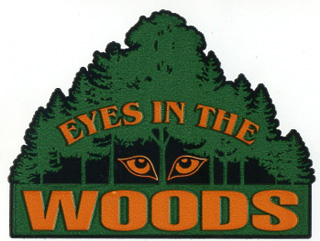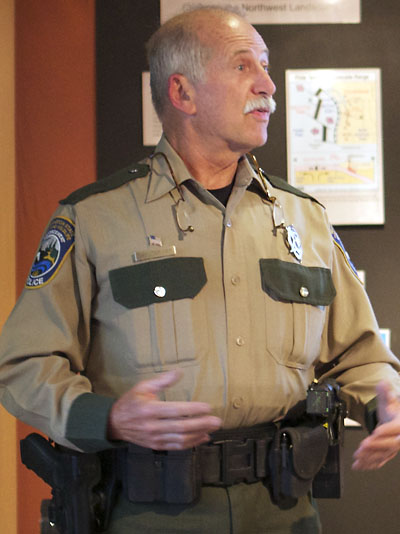home | internet service | web design | business directory | bulletin board | advertise | events calendar | contact | weather | cams

 The non-profit Eyes in the Woods Association sponsors training for volunteer observers. Image courtesy Eyes in the Woods Assocation The non-profit Eyes in the Woods Association sponsors training for volunteer observers. Image courtesy Eyes in the Woods AssocationForest Watch Local game wardens for the Washington Department of Fish and Wildlife last week trained a dozen Methow Valley residents to help bring wildlife poachers and other natural resource lawbreakers to justice. Similar to a Neighborhood Watch for the woods, citizen volunteers were taught how to observe, document and report natural resource crimes such as garbage dumping, timber cutting, taking fish or baiting and poaching animals. The two-hour June 13 class was sponsored by the non-profit Eyes in the Woods Association, Inc., and taught by local WDFW game enforcement officer Cal Treser, who lives on Balky Hill and whose jurisdiction extends from Rainy Pass to the Columbia River and from Lake Chelan to the Canadian border. Officer Jason Day, who lives in Carlton but works the south Okanogan-north Douglas county area, joined Treser as co-instructor. Treser, who has been with the department for more than 30 years, said when he first moved here, he parked in his own driveway the day general deer season opened and “wrote seven citations for shooting from a vehicle and shooting from the road,” both of which are illegal. “They even shot a deer in my yard,” he said of the irresponsible hunter behavior. (It is illegal to hunt on private property without permission from the owner and illegal to follow an animal shot on public land onto private land without the owner’s permission.) Day told class members he knew they wouldn’t think twice about reporting a burglary in progress or a car break-in and they should take natural resource crimes just as seriously because they are crimes against what we all own. “We don’t need people stealing our resources,” Treser added. He said the reason he took his Methow Valley job is “because we have all this wildlife… Without laws we wouldn’t have the wildlife we do today.” “And we live in a time of shrinking habitat and dwindling numbers of wildlife,” Day said. The Local Poaching Problem  Jason Day, Washington Department of Fish and Wildlife game enforcement officer, works the south Okanogan-north Douglas county area. Jason Day, Washington Department of Fish and Wildlife game enforcement officer, works the south Okanogan-north Douglas county area.In a post-class interview Treser told Grist that when he arrived here in 1999, the amount of poaching was terrible. It would start about July, he said, with “people coming from the west side with hounds and baiting bear.” In August it would be archers. In September he got “at least one complaint every week of shooting at 2 a.m. on the Big Valley Ranch.” He said he ended that problem by parking out there and working evenings. When general deer season opened in October, Treser said the problem would be hunters, again mostly from the west side, shooting illegal deer, hiding them in places like culverts, then coming back for them later. Over the years, he has “pretty much” licked all but one problem – the Thanksgiving season poaching of trophy size mule deer bucks. The big bucks don’t come down to the valley floor until November, he explained, “and they are in rut so they are just stupid.” The poachers spotlight and shoot them in the evening, he said. “Last year I lost two deer on Thanksgiving night.” But some years he doesn’t lose any of the big bucks because he knows where to station himself. He said when he first got here it wasn’t unusual to lose 5 to 10 big bucks to poachers. It would be impossible for the two officers to patrol the vast territory in their jurisdictions so they have to rely on citizens to alert them to illegal activities, they said. Both men said they respond to calls at any time of the day or night. Bear Baiting They also cautioned that while it may seem like nothing is happening in response to a complaint, it sometimes takes years to build a major case. For example, Treser worked for six years gathering the evidence needed for the high-profile Cub Creek bear-baiting case involving a Pierce County man who baited bears near his Methow Valley cabin. It’s been illegal to bear-bait in Washington state since 1996. Originally charged with more than 40 counts of baiting and killing black bears, James Erickson, of Eatonville, Wash., entered a plea deal in April 2012 that meant he received minimal jail time, paid a fine and lost hunting privileges for a number of years. “These bear become habituated to people food and are no longer afraid of people,” Treser said. “They get addicted to sugar,” Day added. Up to 15 bears were using the Cub Creek bait site, according to Day. Before the crime was stopped, numerous bear complaints in Treser’s jurisdiction were coming from the Chewuch, Rendezvous and Cub Creek areas, he said. “Since we caught the guy there’s only been one complaint,” Day added.  Cal Treser is the game enforcement officer for the Methow Valley. Cal Treser is the game enforcement officer for the Methow Valley.How to Report The class was shown a short video of a staged deer-poaching incident, then asked to describe in detail the vehicle and individuals involved. Getting a license plate number and recording details about the location can be critical information for an enforcement officer who may arrive hours later to gather DNA samples and other evidence at the site, the instructors said. Class members were encouraged to make written notes of their observations, and limit them to what they witness first hand. It also was emphasized that Eyes in the Woods is a “non-confrontational program.” Those trained are to gather information, not try to personally intervene. Who to Call To report poaching in progress or an emergency dangerous wildlife incident, call 911, the trainees were told. Another fast-response option is to call the Washington State Patrol, which dispatches WDFW enforcement officers. If they are out in the field beyond cell phone range, the WSP can reach them by radio, the officers said. The number to call is 1-509-422-3800, then press 0. WDFW maintains a toll-free emergency incident hotline at 1-877-933-9847, which is staffed from 8 a.m. to 5 p.m., Monday through Friday. “With more people out and with cell phones, we’re able to get more information,” said Treser. Becoming a Witness Eyes in the Woods was founded in 1998 and works with the WDFW on a variety of projects, including offering the two-hour Crime Observation and Reporting Training class. Participants receive certificates stating they are Certified Witnesses and their names are added to a roster of trained individuals. Treser explained that when officers are putting together a case, having information from a trained witness carries weight with the court. But he also told participants that the chances they would ever have to go to court to testify are minimal. “There’s only been one time in 34 years when somebody went to court to testify” in one of his cases, Treser said. Most of the information gathered is used anonymously. And to those who may be afraid of retaliation, he said he couldn’t think of a single instance. “Most peoples’ consciences kick in,” he said, and they own up to what they’ve done. Treser said what he cares about above all is enforcing the law fairly and equally. “This isn’t just a job, it’s our life.” For more information about Eyes in the Woods programs go to www.eyesinthewoods.org 6/17/2013 Comments
|